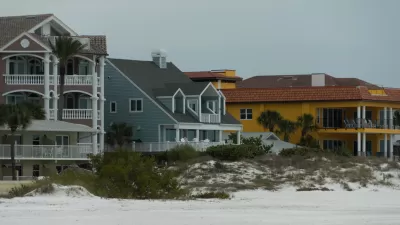As Oregon's coastal beaches erode, taking valued public space with them and exposing private property to increased risks from flooding and sea-level rise, some local governments want to allow property owners the right to "armor" the coast.

After decades of enforcing a state law banning construction of rip-rap, or a barrier constructed of large rocks, along the coastline, Tillamook County, Oregon has decided to toss the state law and allow coastal homeowners to reinforce the coastline to protect their homes, according to an article by Kristian Foden-Vencil for OPB.
"Oregon land-use rules largely ban shoreline armoring, under what’s known as Goal 18," explains Foden-Vencil in the article. "The policy, adopted back in 1977, banned the use of rip rap to protect new development, unless the site qualified for an exception."
Goal 18 was adopted to protect the natural features of the Oregon Coast, but scientists have also shown that rip rap "changes the wave action on a beach, scouring away sand and potentially leaving no beach for the public to enjoy," according to the article.
"So there’s a natural friction between the hundreds of thousands of Oregonians who live on the coast and want their properties protected from the ocean, and environmentalists and visitors who vacation here and want to protect the beautiful vistas."
As reported in the source article below, Tillamook County, located on the Oregon Coast directly west of Portland but south of the mouth of the Columbia River, has recently begun to favor rip rap over public beaches.
But environmentalists aren't allowing the shift in land use policy without a legal fight. "The Oregon Shores Conservation Coalition is fighting Tillamook County’s decision and taking the Pine Beach case to Oregon’s Land Use Board of Appeals, or LUBA. They’re joined in their case by the Surfrider Foundation and the Oregon Department of Land Conservation and Development," reports Foden -Vencil.
FULL STORY: Oregon’s land-use rules bump up against increasingly crowded shorelines

Alabama: Trump Terminates Settlements for Black Communities Harmed By Raw Sewage
Trump deemed the landmark civil rights agreement “illegal DEI and environmental justice policy.”

Planetizen Federal Action Tracker
A weekly monitor of how Trump’s orders and actions are impacting planners and planning in America.

The 120 Year Old Tiny Home Villages That Sheltered San Francisco’s Earthquake Refugees
More than a century ago, San Francisco mobilized to house thousands of residents displaced by the 1906 earthquake. Could their strategy offer a model for the present?

In Both Crashes and Crime, Public Transportation is Far Safer than Driving
Contrary to popular assumptions, public transportation has far lower crash and crime rates than automobile travel. For safer communities, improve and encourage transit travel.

Report: Zoning Reforms Should Complement Nashville’s Ambitious Transit Plan
Without reform, restrictive zoning codes will limit the impact of the city’s planned transit expansion and could exclude some of the residents who depend on transit the most.

Judge Orders Release of Frozen IRA, IIJA Funding
The decision is a victory for environmental groups who charged that freezing funds for critical infrastructure and disaster response programs caused “real and irreparable harm” to communities.
Urban Design for Planners 1: Software Tools
This six-course series explores essential urban design concepts using open source software and equips planners with the tools they need to participate fully in the urban design process.
Planning for Universal Design
Learn the tools for implementing Universal Design in planning regulations.
Clanton & Associates, Inc.
Jessamine County Fiscal Court
Institute for Housing and Urban Development Studies (IHS)
City of Grandview
Harvard GSD Executive Education
Toledo-Lucas County Plan Commissions
Salt Lake City
NYU Wagner Graduate School of Public Service





























